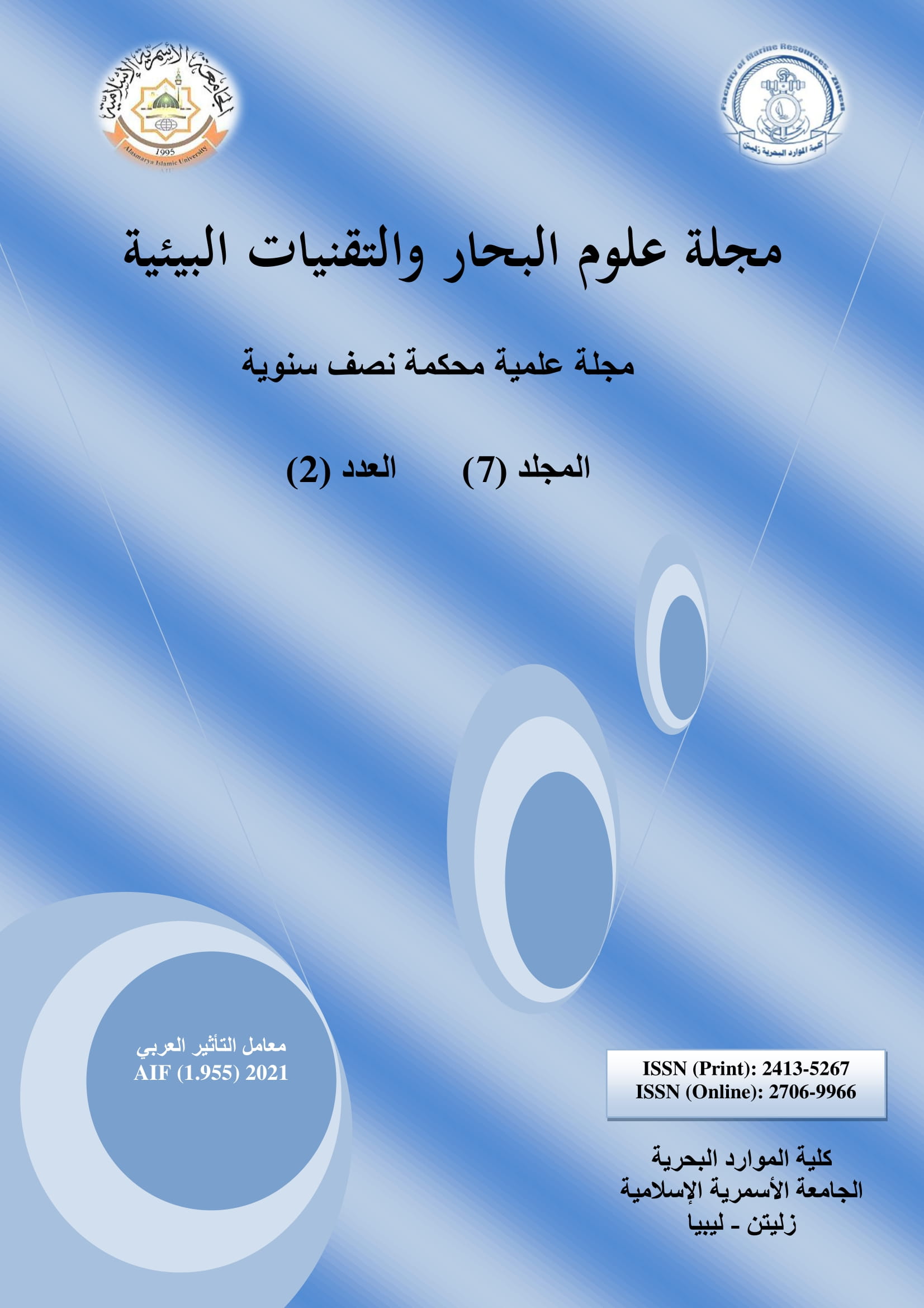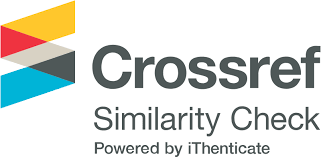طبقات لانقمير وبلوجت من حمض الاوكتاديكانويل أحادي الهيدروكسيد كمانع ضد تآكل النحاس
DOI:
https://doi.org/10.59743/jmset.v7i2.20الكلمات المفتاحية:
حمض أحادي هيدروكسيد، أفلام لانغمير وبلوجت، النحاس، التآكل، EISالملخص
تم تغطية سطح نحاسي بعدة طبقات على شكل طبقات لانقمير وبلوجت من احماض الاوكتاديكانويل أحادي هيدروكسيد (C18N) في وجود وفي عدم وجود ايونات الحديد الثلاثية (Fe3+). وقد تم دراسة تأثير هذه الطبقات كمانع لتآكل النحاس في محلول كبريتات الصوديوم ذو تركيز مولي 0.1 بواسطة عدد من التقنيات المختلفة مثل الاستقطاب الديناميكي القوي والتنظير الطيفي للمقاومة الكهروكيميائية (EIS). بالإضافة إلى ذلك، تم تصوير الأسطح النحاسية باستخدام المجهر الإلكتروني للمسح الضوئي (SEM). وقد أظهرت النتائج أن أعلى كفاءة تثبيط (92٪) تحققت من خلال فيلم لانقمير وبلوجت من 5 طبقات أحادية الجزيئية من الحمض في وجود أيونات الحديد. كما تم استنتاج أن هذه الطبقات تعمل كمثبط كاثودي والتي تمنع تفاعل القطب السالب.
وجود الأيونات يحسن بشكل كبير من كفاءة التثبيط من خلال تشكيل طبقة كثيفة أكثر إحكاماً والتي تمنع تدفق الأيونات العدوانية إلى السطح المعدني. كما تم دراسة تأثير وقت الغمر على الخصائص المثبطة لأفلام لانقمير وبلوجت على سطح النحاس.
التنزيلات
المراجع
Al-Taher F., Rigó T., Telegdi J., & Kálmán E. (2005). Inhibition of copper corrosion by LangmuirBlodgett layers of hydroxamic acid salts. Proceedings of the 10th European Symposium on Corrosion and Scale Inhibitors (10SEIC), Italy, 2005, pp. 925.
Al-Taher F., Telegdi J., & Kálmán E. (2007). Effect of divalent cations in LB films on the protection of copper against corrosion. Materials Science Forum, 537-538, 9-14.
Al-Taher F., Telegdi J., & Kálmán E. (2008). Langmuir films of monohydroxamic acid on various ion-containing subphases. Colloids and Surfaces A: Physicochemical and Engineering Aspects, 321(1-3): 34-38.
Bellakhal N. & Dachraoui M. (2004). Study of the benzotriazole efficiency as a corrosion inhibitor for copper in humid air plasma. Materials chemistry and physics, 85(2-3): 366-369.
Blomgren E. & Bockris J.O.M. (1959). The adsorption of aromatic amines at the interface: mercury-aqueous acid solution. The Journal of Physical Chemistry, 63(9): 1475-1484.
Bregman J.I. (1963). Corrosion Inhibitors. Macmillan, NY.
Gonzalez S., Laz M.M., Souto R.M., Salvarezza R.C., & Arvia A.J. (1993). Synergistic effects in the inhibition of copper corrosion. Corrosion, 49(6): 450-456.
Granese S. L. (1987). Study of the inhibitory action of nitrogen-containing compounds. Corrosion Sci, 44(6): 322-327.
Grundmeier G., Reinartz C., Rohwerder M., & Stratmann M. (1998). Corrosion properties of chemically modified metal surfaces. Electrochimica acta, 43(1-2): 165-174.
Guo D., Xing W., Shan Y.B., Lu T.H., & Xi S.Q. (1994). Inhibition of corrosion by hexadecyl trimethyl ammonium bromide Langmuir-Blodgett monolayers on carbon steel. Thin Solid Films, 243(1-2): 540-543.
Huynh N., Bottle S.E., Notoya T., Trueman A., Hinton B., & Schweinsberg D.P. (2002). Studies on alkyl esters of carboxybenzotriazole as inhibitors for copper corrosion. Corrosion science, 44(6): 1257-1276.
Itoh M., Nishihara H., & Aramaki K. (1994). A Chemical Modification of Alkanethiol Self‐Assembled Monolayers with Alkyltrichlorosilanes for the Protection of Copper Against Corrosion. Journal of the Electrochemical Society, 141(8): 2018-2023.
Jaiswal A., Singh R.A., & Dubey R.S. (1999). The effect of LB-films of N-octadecylbenzidine on the electrochemical properties of copper in sea water with and without microbes. Bulletin of electrochemistry, 15(2): 49-53.
Jaiswal A., Singh R.A., & Dubey R. S. (2001). Inhibition of copper corrosion in aqueous sodium chloride solution by N-octadecylbenzidine/1-docosanol mixed Langmuir-Blodgett films. Corrosion, 57(04).
Jennings G.K. & Laibinis P.E. (1996). Self-assembled monolayers of alkanethiols on copper provide corrosion resistance in aqueous environments. Colloids and Surfaces A: Physicochemical and Engineering Aspects, 116(1-2): 105-114.
Kaesche H. & Hackerman N. (1958). Corrosion inhibition by organic amines. Journal of the electrochemical society, 105(4): 191.
Laibinis P.E. & Whitesides G.M. (1992). Self-assembled monolayers of n-alkanethiolates on copper are barrier films that protect the metal against oxidation by air. Journal of the American Chemical Society, 114(23): 9022-9028.
Luka Noč, Matjaž Ličenc, Irena Drevenšek Olenik, Raghuraj Singh Chouhan, Janez Kovač, Daniel Mandler, & Ivan Jerman (2021). Solar Energy Materials and Solar Cells, Vol. 223.
Meucci S., Gabrielli G., & Caminati G. (1999). Materials Science and Engineering, C8-9: 135.
Notoya T. (1978). Corrosion Inhibitors for Copper and Copper Alloys. Corrosion Engineering, 27(12): 661-670.
Nozawa K., Nishihara H., & Aramaki K. (1997). Chemical modification of alkanethiol monolayers for protecting iron against corrosion. Corrosion Science, 39(9): 1625-1639.
Patil S., Sainkar S.R., & Patil P.P. (2004). Poly (o-anisidine) coatings on copper: synthesis, characterization and evaluation of corrosion protection performance. Applied surface science, 225(1-4): 204-216.
Románszki L., Datsenko I., May Z., Telegdi J., Nyikos L., & Sand W. (2014). Polystyrene films as barrier layers for corrosion protection of copper and copper alloys. Bioelectrochemistry, 97: 7-14.
Shaban A., Kálmán E., & Telegdi J. (1998). An investigation of copper corrosion inhibition in chloride solutions by benzo-hydroxamic acids. Electrochimica acta, 43(1-2): 159-163.
Stupnišek-Lisac E., Gazivoda A., & Madžarac M. (2002). Evaluation of non-toxic corrosion inhibitors for copper in sulphuric acid. Electrochimica acta, 47(26): 4189-4194.
Stupnisek-Lisac, E. & Gasparac R. (2000). Corrosion inhibition of copper in hydrochloric acid under flow conditions. Corrosion, 56(11): 1105.
Telegdi J., Rigó T., & Kálmán E. (2004). Nanolayer barriers for inhibition of copper corrosion. Corrosion engineering, science and technology, 39(1): 65-70.
Telegdi J., Rigó T., & Kálmán E. (2005b). Molecular layers of hydroxamic acids in copper corrosion inhibition. Journal of Electroanalytical Chemistry, 582(1-2): 191-201.
Telegdi J., Rigó T., Beczner J., & Kálmán E. (2005a). Influence of Langmuir-Blodgett nanolayers on microbial adhesion. Surf. Eng,. 21: 107-112.
Ulman A. (1991). An Introduction to Ultrathin Organic Films: From Langmuir--Blodgett to Self-Assembly. Academic press, Boston.
Volmer M., Stratmann M., & Viefhaus H. (1990). Electrochemical and electron spectroscopic investigations of iron surfaces modified with thiols. Surface and Interface Analysis, 16(1-12): 278-282.
Volmer M., Reynders B., & Stratmann M. (1991). Anbindungsverhalten organischer Monomere auf Eisenoberflächen und Korrosion der durch die Anbindung chemisch modifizierten Oberflächen. Materials and Corrosion, 42(1): 19-34.
Wolpers M., Stratmann M., Viefhaus H., & Streckel H. (1992). The structure and stability of metal surfaces modified by silane Langmuir-Blodgett films. Thin solid films, 210: 592-596.
Xing W., Shan Y., Guo D., Lu T., & Xi S. (1995). Mechanism of iron inhibition by stearic acid Langmuir-Blodgett monolayers. Corrosion, 51(1): 45-49.
Yamamoto Y., Nishihara H., & Aramaki K. (1993). Self‐assembled layers of alkanethiols on copper for protection against corrosion. Journal of the Electrochemical Society, 140(2): 436.
Zhu Y., Free M.L., Woollam R., & Durnie W. (2017). A review of surfactants as corrosion inhibitors and associated modeling. Progress in Materials Science, 90: 159-223.
التنزيلات
منشور
إصدار
القسم
الرخصة
الحقوق الفكرية (c) 2021 مجلة علوم البحار والتقنيات البيئية

هذا العمل مرخص بموجب Creative Commons Attribution 4.0 International License.












